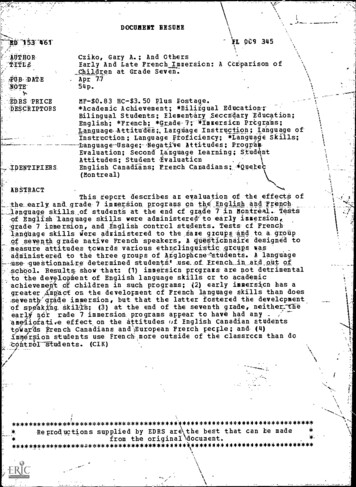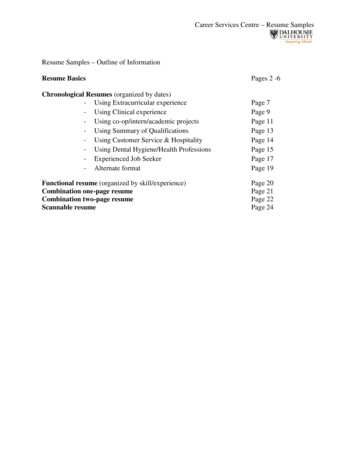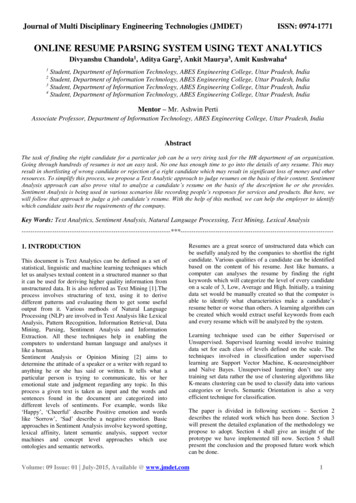
Transcription
DOCUMENT RESUMEEL o-C9 345-Ttv461'4TB-DATECziko, Gary A.; And OthersEarly And Late French Immersion: A Comparison ofChildren at Grade Seven.Apr 77:NOTE'54p.1pttiort-:EDRS PRICEDESCRIPTORSMF- 0.83 HC- 3. 50 Plus postage.*Academic Achievement; *Bilitgual Education;Bilingual Students; Elementary Seccndary Education;English; *French; *Grade-7;-*Immersicn PrCgrais;LanguagemAttitudeS;.Largdage Instruction; Iainguage ofInstruction; Language proficiency; *Language Skills;---.Language-Usage;- -Negative Attitudes; ProgpillEvaluation; Second language Learning; StudentAttitudes; Student valuaticnEnglish Canadians; French Camadiansr *Quetec(Montreal)ABSTRACTThis repert describes at evaluation of the effectO ofand grade 7 immersion programs on the English,and:FrenchAangnage skills of student's at the end cf grade 7 in Montreal. Testsolf English 'language skills were administered'to-early immersion,*ade 7 immersion, and English control students. Test cf Frenchlangtage skills ere administered to the .same gxcupsand to, a. grOdpof seventh grade native French speakers. A 400Stichndire designed to-measure attitudes towards various ethtolinguiStic cups 'NOadministered to the three groups of Aigloplioneestudents. A languagegueStionnatre determined studentS.I mse of Erench in ard.ont of.school. Results. show that: (1) immersion programs are not detrimentalto the development of English language skillS cr to academicachievemenit of children in such programs; (2) early immersion has agreater Xmpact on the development cf French language skills than doesselienth,'grade immersion, but that the latter fostered the develtpment(3) at the end of the seventh grade, neither:fhbof spefakilgearl" nor rade 7 immersion.programs appear to have had anyeffect on the attitudes of English Canadian studentstoijards French Canadians aneiEuropean Frerch people; and (4)Immersion students use French more outside of the classroom than *Reproductions supplied by EDRS arkthe best that can be made**from the ************k*****************************
U S. DEPARTMENT OF HEALTH,EDUCATION &WELFARENATIONAL INSTITUTE OFEDUCATION'PERMISSION TO REPRODUCE THISMATERIAL HAS BEEN GRANTED BYTHIS DOCUMENT HAS,, BEEN REPRO -,OVCEO EXACTLY AS RECEIVED., FROM.THE PERSON OR ORGANIZATION ORIGINATING IT POINTS OF VIEW OR OPINIONS'STATED 00 NOT NECESSARILY REPRESENT OFFICIAL NATIONAL INSTITUTE OFEOUCATION POSITION OR POLICYWallace 8.LetuiertEARLY AND LATE FRENCH IMMERSION:TO THE EDUCATIONAL RESOURCESINFORMATION CENTER (ERIC) -AND-----A-COMrARISON OF CHILDREN AT GRADE SEVENUSERS OF THE ERIC SYSTEM?'1 2'Gary A. Cziko, Naomi Holobow & Wallace E. LambertMcGill UniversityrfOver the past twelve years the South. Shore' protestant Regional School Board (SSPRSB) has developed andiMplemented a number or innovative educationa .programs forteaching Of,French to English - speaking, Canadian children.Inthe first of those, thelsod.called "early" French immersion program,"an English-speaking child receives all of 'his. kindergarten andgrade 1 instruction in Fiench while attending an ibglish school.with English classmates.in grades 2 or 3, English is gliaduallyintroduced into the program until at grade 4 on and through grade,6:approxikately half of the instruction is in. French and half inEnglish" (Bruck, Lambert, & Tucker, 1976).Although the early immersion program has been verysuccessful in producing a high degree of proficiency in Frenchwithout detrimental effects on the development of English-languageskills or academic achievement (see Lambert & Tucker, 1972), andhas served as a model for similar programs across Canada (seeSWain, 1972), it was perhaps inevitable that alternative programswould be developed by the SSPRSB to providintensive training inFrench for those children who, for whatever reason, had not emsrolled in the French immersion program in kindergarten or grade 1.April 19772
2Tito, such "late" immersion,programs are presently offered by theSSPRSB: a 'grade 4' immersion program and a grade 7 immersioniik*AinfThe grade,,4 immersion program, now in its third yearof existence, is designed for children who hava followed theconventional Englisholanguage program with Frenciviap4Olecond,;-language (FSL) instruction from grades 1 through 3.Immersion-starts.at grade h, when French is introduced as the sole languageof instruction except for one daily claim (approximately 35minutes) Of English Language Arts.At grade 5, French immersionis out-and-English is-reintroduced as-the' language-ofinstructionoiceipt for approximately 40 minutes of FSL instruction per dayand 50 minutes per day of mathematics instruction given in French.In the first evaluation of this program it was found that theprogram was effective in fosteringFrench-language skillswithout retarding the development of English-language skills orinterfering with the learning of content subjects (Cziko, 1975).I follOw-up study replicated these same general findings and inaddition found that, at the end of grade 5, pupils who had beenin the grade 4 imnersion program still retained their- "edge" inIFfendh over those pupils ite.:;o had had no innoiisiith okOokionce,although the early immersion program appeared to have a deeper,/impact on the development of French-language skills than thegrade h. immersion program (Cziko, Holobow, & Lambert, 1977).3
3Like the grade 4 immersion program, the grade 7,immersion program is for children Who have not had any previousFrench immersion experience.oilstonee longer than theWhile this program has:been ingrade 4 immersion program, attempts tocompare the-effectiveness of the grade 7 program with the earlyiimiersion-program have lead to somewhat inconsistent findings.In- he firit evaluation of thegrade 7 immersion program it wasfound that students at the end of the grade 7 immersion yearPOtorried at the same level or better on iteasursisok FrenchlangUige skills than a group of grade 7 studontt\who hid-,comPletedt2 itilthertieri program (Bruck, LiMhort, & Tuoker, 1175).Bbirov*r, as the authors pointed out, the students compared in thisstudy were most likely not representative of students in the earlyand grade 7 immersion programs.A-re-eiraluation. of these-'two-programs the following year with other more representative groupsof students found that the early immersion-students generally.performed better than the grade 7 immersion students on measures ofFrench reading* writing, listening, and speaking sLilla (Bruck,Lambert* '& Tucker, 1976).wasIn addition, the same patteri of findingsreported in a preliminary and follow-up evaluation of a compar-able grade 7 immersion program offered by the Protestant SchoolBoard of Greater Montreal.Genesee and Chaplin found,in l975,thattheir grade 7 immersion group had performed at the same leval as anel.arly immersion group on tests of French reading, listening, andspeaking skills but a year later when Genesee (1976) studied
f011on-mup groups of a'.udents, the early immersion groupgarpiesed the grade 7 immersion group on all testa of Frenchlanguage skills.The present report is another and more recentevaluation of the effects of the early and grade 7 immersion,programs on the English and French language skills of studentsat the end of grade 7.For this purpose, tests of English-language skills were administered to early immersion, grade 7inkerision, and English control students.Vests of French-language skills were administered not only to the two immersiongxOups but also to the English control students and-to a group-ofseventh grade native French-speaking students, permitting us toassess the French - language skills of pupils in the more traditional FSL program and to better dociiment the effects of tho earlyand grade 7 immersion programs.Finally, a questionnairedesigned to measure attitudes toward- various ethnolingusticgroupt was administered to the three groups of Anglophonestudents in order to investigate the affective consequences ofthese three different French-language programs, and a "languageuse" questionnaire was also administered to these same studentsto-provide detailed information on their use of French in andout of school.5
5METHODSubjectsThe four groups of students tested are described:below.Grade Seven gaglish Control (7E).This groupcomprised 18 students who had followed the conventional English,langmage school curriculum from Kindergarten through. grade. 1with ,approximately 45 minutes per day of Frendh-assecondlanguage (FSL) instruction from grades 1 through 7.Grade Seven Immersion (71).These 24 students hadparticipated in the one-year French immersion option at theseventh grade level.In elementary school their basic instruc-tion was in English wIth approxlmateI5i 45 minutes per day of FSLinstruction from grades 1 through 6.In'the seventh grade,approximately 70% of their curriculum was taught in French.Grade Seven Post Bilingual (7B).These 30 studentshad been partOf' the early immersion program from kindergartenthrough grade 6 (at grades 5 and 6 about 60% of the curriculumwas taught via French).At grade 7 they followed a traditionalEnglish secondary school program, except that they had theoption of taking a content, subject in French.Their curriculumincluded a mandatory French language arts course specially41.designed for their level of experience in French.6
-6'Thus, these students were no longer in an immersion programat the time of testing.Grade Seven French Control (7F).This group comprised34 Francophone students who attended a French secondary schoolin the same noighborhood as the English children.They werealso at the grade 7 level.MATERIALSA series of group and individual tests were administered, some during the beginning of the school year andothers towards the end.These tests were designed to provideinformation about: .(a) Intellectual functioning, (b) Englishlanguage skills, (c) French language skills, (d) Attitudestowards ethnolinguistic groups.Intellectual FunctioningThe Canadian Lorge Thorndike Intelligence Test wasadministered to the students of groups 7E, 71, and 7B.This isa group intelligence test with a verbal (English-language based)and a nonverbal section, standardized on a Canadian population.Raw scores were converted to derived IQ's, taking into accounteach child's age.English Language SkillsThe following tests of English language skills wereadministered to students of groups 71, 7B, and 7E.7
7The Advanced Form "F" of the Metropolitan AchievementTests language subtests.These subtests include "Word Knowledge","Reading Comprehension", "Language", and "Spelling ".The"Language" subtest measures skills in English capitalization,punctuation and usage rules.The Metropolitan Achievement Testsare a graded series of tests, in multiple-choice format,standardized on large groups of American children.They allowfor comparisons of a particular student or groWof studentswith others of the same age and grade level.The Canadian Testa of Basic Skills,The four subtextsfor Eagliah Language skills are "Vocabulary ", "keading Compre.-hension", "Work Study Skills", and "Language", the lattertapping knowledge of English spelling, capitalization,punctuation, and usage rules.The CTBS is similar to the MAT,but it has been standardized on a Canadian population.Thecomposite score (which includes the above-mentioned languagesubtests plus subtexts of mathematics concepts : id problemsolving). was used as a measure of general academic achievement.French Language SkillsThe following tests of French Language skills weregiven to groups 7E, 71, 7B, and 7F, with the exception of Frenchlistening OISE test which was not given to groups 7E and 7F andthe test of French speaking skills which was not given to the7Fgroup,8
,-8French Reading Comprehension,adminiiteredTwo tests wereto see how well students could read and under-stand both technical and non - technical material.TheTestde Lecture "California", a French adaption of the California;Reading Test, was selected to measure reading comprehension oftechnical material.A subtest called "comprehension atinterpietation du texts" was selected from the highest level(Cycle infgrieur de l'enseignament secondaire) equivalent toGrade 7.It consists of four brief articles followed by aseries of multiple-choice questions based on the preceding test,The topics of the four articles are 1) the history of aluminum2) the fishing industry 3) the history of the telegraph andI) coats of arms.The students were allowed twenty minutes tocomplete the test.The score for each pupil was the number ofcorrect responses out of 30.An article from La Press., one of Montreal's dailyrenoh-language newspapers, was selected to measure readingcomprehension of non - technical material,The article concernedYvon Deschamps, a well-known French-Canadian entertainer.Thestudents were then asked to respond with essay-type snortanswers to nine questions designed to test their comprehensionof the article.They W07.41 allowed to reread the article whileanswering the questions.All test instructions and questionswere/givenin French and the students were allowed 30 minutes,,to complete the test.9
9The tests were corrected se 'Qarately by two Francophoneuniversity graduates who later discussed discrepancies andagreed on a final mark.The total possible score was 14.French Writing Skills.Two tests were administeredto measure both productive and receptive aspects of Frenchwriting skills.A three-minute film loop entitled "Quick Change"was used to exaline the students' productive abilities.This isa short skit in which meaning is conveyed through pantomime.After seeing the film, the students were asked to barite a narrinative deicription of it.-both -form-and content.Their compositions were scored forThe following measures were used for thefamiluatImILL1. Number of spelling errors (orthographe d'usage;mayson, it dons);2. Number of spelling errors for verbs. These weregrammatical in nature (e.g., Il les a donna vs.down s);(e.g., I1 donnez vs. donnait);3. Number of other spelling errors of a grammaticalnature (e,g., les fillet vs. lea filles);4. Number of verb errors (wrong tense, lack ofagreement, wrong auxiliary);5. Number of incorrect sentence structures (e.g., acause que vs, a cause de );(e.g., la filljolie vs. la Joliet fills);6, Number of incorrect genders;7. Number of inappropriate vocabulary terms (a Frenchword is used inappropriately, e.g., depuis vs,pendant; demeurer vs. habiter);10
108. Number of Anglicisms (English words translatedinto French, but which in fact arelhot-Frenchwords, e.g., discourager vs. decourager);9. Number of English words;10. Total number of errors,Each of these error types was divided by the totalnumber of words in the composition.Thus, for each of theabove categories each student received two scores:a rawscore (e.g., total number of errors with gender) and a ratioscore (e.g., gender errors/total words in composition).Thislatter score was used to control for length of composition.The following measures were used in the contentanalysis.A list of the 10 most important details of thefilm was compiled.Each composition was examined to see howmany of these 10 basic details were reported.Eighteen minordetails were also listed and these, too, were counted.The number of compoSitions that had an (a) introduction; (o) conclusions, and .('c) title were counted.Finally, we counted the number of students who embellished theircompositions by adding narrative that did not take place in theMk.Two French teachers who had seen the film scored eachcomposition separately.They then compared their scores for eachstudent, correcting any existing discrepancies.
11A proof readingexercise was given to measurereceptive writing skills.Sixteen sentences each of whichcontained one spelling, placement, verb form and gender errorwere presented to the students.They were told that thesentences contained errors and they were to find and correctasany as possible.The sentences were scored in the following way:1. Numberaccurate corrections made;2. Number of inaccurate corrections made (anincorrect form, e.g.: tout-los- filles, Waschanged to another incorrect form, touts lesfilles);3, Nuiber of errors ignored;4. Number of correct forms changed whichresulted in errors;Number of.mistakes acknowledged but notcorrected;6. Number of correct forms changed which resultedin other correct forms.These were tabulated separately by categospelling),(place, Verb, gender,Since there were very few entries for categories5 and 6, no formal statistical analyses were performed.French Listening Comprehension.administered to measure thin abili4.Two tests WereThe first test of Frenchlistening comprehension was developed by. the Ontario Institutefor Studies in Education(OISE).12
12The students answered multiple choice questions based on thestory "Le Mystrs Au P,roiisseurii which was presented by meansof a tape recorder.The tape was not a good copy and thereWas-tome-difficulty in understanding it.The score for eachOwn was the number of correct responses out of 20,The:0066hts were also asked to listen to a recording of a news4frOicipiet taped from an actual program on Radio-Ganada,,s -item-was-a-set-of-multiple chaise questions designed to reflect the-student,*comprehension of the news segments whiCh had directly Preceded.Each question had three response alternatives, one of which wascorrect.In all cases the choices were mutually exclusive.The tape was played only once.Thirty-second pauses followedeach question to allow students to indicate* their" responses onthe answer sheets.outofThe number of questions answered correctly,13, constituted the score.French Speaiking Skills.Four short job descriptions(like those found in classified ads) were written and shown toeach student with the following instructions:"You are to readthese ads and select one job for which you would like to applyfor summer employment.-,,In a short while, you will be interviewed\r,for this job.'These instructions were given in French.Eachstudent 1,:as then interviewed individually by a Francophone re-search assistant.Each student was asked the following questions:13
132.i.1 emploi as-tu choisi?2:Qel age as-tu?3.Est-ce quo tu as dejk fait co genre de travail? Ots? Quand?"\-- Si non, (a) Ties-tu dijk occupe (a) d'un jean eManttNfas-tu jamais-iide aux travaux domottiquet?(b)lave dei fenttrestnettoyi-le terrain'(c) Efas-tu Jamai* mils la table,desservi?Pout-tu-me donner le no* de qiielquels plii.sohnes, avec qui Jopourrais communiquer pour avoir des,tifiiientes?5.Pourrais-tu commencer I plein temp* tout de suite?Si oui, Qu'arriverait-il de tes etudestSi non, Pourquoi pas?6.Serais-tu prSt (e) a habiter chez ton employeur ou prefererais-tu retourner chez toi tous les :gars?Est-ce que ce serait trop loin pour voyager tous lesjours?7.Combien voudrais-tu de Join's de conge par pemaine?8.Combien penses-tu devoir gagner par semaine?9.Peux-tu me dowser le numero de telephone ou Jo pourraistfitteindre. A quells hour devrais-je tfappeler?Dites-leur que les offress d'eaploi no sont pas veritablesat demandez-leur quels sont leurs.projets dlite.14
All interviews were recorded.These were thenirapecribta and scored in two different ways:'net-Subjective ratings.objective ratingsThe following is a discr4tion of the'Objective measures taken.1.The number of questions that the student did notunderstand. This wai inferred when the studentgave ,an inappropriate response (*(ow-much' ,dayou want to make an heart 20.00,-,on fUrtherrepetition, he said 2.50);The number of questions,that the interviewer hadto repeat because the student aiked,him, torepeat them or the student did,not supply.sUPOlyt enoughinformation to satisfactorily answer theThe number of English words the student used inthe interview;4.The number of one word answers that the studentgave. This score was expressed as a ratio'lof thenumber of questions the interviewer asked thestudent.These analyses were performed by Francophone research ,assistants.The following is a description of the subjectiveratings.Two French Canadian graduates (one male, one female)who had no epe'ial knowledge of the project, but were familiarwith the educational options available to Quebec -Anglophoneyoungsters, were asked to listen to each interview and to makethe following judgments.15
comprend les questions que l'interviewer luiiTassel:4.11111 MIMMIN111101111111.110.04;par-la. plupartfeiteisntdu temps3.quelquesimmanentpas du toutLietudiant semblaft:tris a l-sal -aQuant au numgro de-telephone, est-ce que 14etudiantsrepondait naturellement et Vitoseablait hesiter comedevait traduire lenuaero (da telephone) de l'anglais au francais4- Evaluoz la facilite d'expression de l'itudiantsfrancaiscourantdifficulted'expressionen francais5- Solon roue, est-ce que l'itudiant eatsfrancophoneanglophone (avec un an d'immersion frangaise)0/1111anglophone (avec plusieurs annees d'immersionfrangaise)Attitudes Toward Selected Ethnolinguistic GroupsThis test was devised by Lambert, Tucker, and d'Anglejan(1973) to assecs children's reactions to four groups of peoples16
16,English Canadians, French anadians,,EUropean French, and myself,adjective rating sc'Sles.A mark of 7-wasassigned to the adjective found to. pOrtray a good human quality,anMirka ranged downwards to 1, which portrayed what was foundidto-be an undesirable quality.The thirteen adjective sets werepresented in different orders for each\of the foui ethnolin.guistic groups, and were administered to the childreniof groups71; lit, and 7EC.All groups rated English Canadians first, thenFrench Canadians, then European French, and finally themselves.Lsnguatte Use .QuestionnaireStudents of groups 7E, 71, and 7B completed a languageuse questionnaire so thae couldNobtain detailed informationon their use of French both in and out of schoOl,Testing ProcedureWith the exception of the CTBS and CLT, all tests andquestionnaires were administered in June,1976, by a team of bilingualexaminers.The CTBS had been administered to the students ofgroups 7E, 71, and 7B in October of 1974 (grade 6), 1973 (grade 5),1972 (grade 4), and 1971 (grade 3), although only the 1971 and1974 results are included in this report.The CLT was administeredto these same students in October of 1974 (grade 6) and 1971(grade 3).Both the CTBS and CLT had been administered by schoolpersonnel and results were obtained from school records.
17In general, the testing conditions of student; fromTOUpt 7E, 71, and 78 (who were all housed in the same school),Were tar from optimal.Since, the weather was unusually hot andthe Students were in the midst of writing final examinationsit was-not the ideal time for adminitliaring,our tests andN.-questionnaires,We experienced particularly bad\distiplineproblems with group 71.The students of group 7F 'were generallymore manageable, except for some discipline problems' during theFrench writing test which was written immediately prior to afinal examination.Statistical ProceduresSeparate one-way analyses -of ,variance were performedfor all measures of English language skills, academic. achievement,and selected items of the Language Use Questionnaire with groupas the independent variable.When significant F-ratios were found,the Newman-Keuls procedure was used to test for significantdifferences between all possible pairs of group means,For measuresof intelligence, t-val4ftswere computed to compare the performanceof groups 7E and 71 combined vs, group 7B.To investigate group differences in performance on thetests of French language skills, in addition to\seParate one-wayanalyses of variance, multiple t-teits were computed comparingthe performance of group 7F vs. group 7B;,,group 7B vs. group 71 and onthose tests administered to group 7E as \aell, group 71 vs. group 7E.18
18,/though these comparisons are not statistically independent,it was thought that these fa priori' comparisons were the moreappropriate tests because we expected on French tests thatgroup. 7F would perform best followed in order by groups 7B, 71and 7E.To analyze the results of the attitude questionnaire,a three by four analysis variance was carried out for each of the13-traits, with the groups being rated (i.e.,- myself, EnglishCanadians, French, Canadians, and European French; and the groupsmaking the ratings (i.e., 7E, 71, and 7B), as the independentvariables.In those cases where a significant interaction was.found, the differences among all 12 means were tested using theNewmanKeuls procedure.RESULTS AND DISCUSSIONIntellectual Functioning{The results of the CLT nonverbal and verbal IQ subtests,administered to groups 7E, 71, and 7B in October, 1971 (grade 3)and October, 1974 (grade 6), are presented in Table 1.The resultsof groups 7E and 71 were combined in this analysis since at thetime of testing group 71 had not yet had any French immersionexperience and were at that time part of the English control group.Students in group 7B scored significantly higher on theCLT non-verbal IQ test administered in October,1971,(at grade 3)19
19Ihin.the eombined U-7X group.However,, the combined 7E!.71-group showed a significantly greater increase in nonverbal IQbetween grades 3 and 6 than group 7B.difference-1mm* found on theNo significant group1971 or 1974 measures of verbal'IQ nor on tMo.19-19714. difference scores.It ie,difficult to explain the differences iiiponyerb41;c1 between Children with and without French immersion.experience.One possible explanation is that the nonverbal IQtest administered in 1971-for some reason seriously underestimated-the nonverbal IQ of both groups of children, especiallyso for the 7E-71 group, thereby inflating the 1971-1974.difference scores for both groups, but more so for group 7E-7I.\\/-'In any case, the most recent IQ data available for these groups(taken in 1974 at grade 6) indlzate no. significant differencesin either verbal or nonverbal IQ and therefore suggest that IQWas not a confounding variable in the comparisons to follow.General Academic AchievementThe mean CTBS composite scores for the combined group7E-7I and group 7B are presented in Table 2.No significantgroup differences were found for either the October,1971 (grade 3)Or October,1974 (grade 6) administrations of CTBS nor were theresignificant group differences in the increment in these scoresfrom grade 3 to grade 6.20
20211BWALAtigglagtailtTable 3 presents the results of EnglishTlanguags.tubtests of the CTBS administered to groups 7E. 71, and 7B inOctOber,1474 (at grade 6) and the English-language subtestsof the MAT given .to the same groups of students in June 1976lit grid 7).NO Significant groups-differences were tOunAon the three CTBS subtests (Vocabulary, Roadingtand Langyage).Significant group differences were found on'the Word Knowledgeand Reiding subtests of the MAT wiAl group 7B performingsignificantly; better than group 7E.No significant groupdifferences were found on ehe Language and Spelling subtesta.ofthe MAT.As in all previous evaluations of the early andgrade 7 immersion programs, we again found no evidence to suggestthat either program has in any way been detrimental to thedevelopment of English-language skills.In fact, where signi-ficant differences did arise, we see the early immersion studentsperforming better than the English control group, not vice versa.Again, as in all previous evaluations of the earlyimmersion program, we find no evidence to suggest that thisprogram has any detrimental effect on academic achievement.French Language Skillslible 1presents the results of all French-languagetests administered to groups 7E, 71, 7B, and 7F.21Significant
21group differences were found on both measureslof readingcomprehension, nine of the 16 measures of writing skills,13 of the 16'sleasureitof proof reading, both- measures oflistening comprehension, and nine of the 11 measures of-speaking skills. -GiVen-the-very large-differences in -theamount: of exposure to French oach group-hail had,; it is notsurprising to find, significant group effects 9!6st of themeasures of French- language skills.What is intet.efiGing,however, ii that ofi--all but two measures, group. differenceswere always in the predicted. direction, i.e., group 7Fbetter than 7B and/or 7B better than 71 add/or 71 betterthan 7E.In only two oases d.td. we find a group With lessexposure to French performing significantly better/thin agroup with more exposure to French.These step -'wise differen-ces, then, appear to represent different approximations tonative-like command of the French language.On one measure of French reading comprehension, the Testde Lecture "California", we find that all three of the predic-ted group differences are signitioaat, i.e., vownnE,while on the "La Presse" test we find 7F)7A)71:27E,no significant difference between the English control andgrade 7 ilimersion groups.Taken together, these resultssuggest thit both the early and grade 7 French immersion22
22programs/have had a definite impact on the Fr- xnch readingof children in these programs and the longer theiiiimmoicmrexperionce, the greater the impact.Note, howeverthat group,7B did not do as well as the French controls oneither -of these two tests.On the nine measures of French writing form, all but three,of the significant group differences were between groups.7F and 7B.Only two significant differences were found be-tween groups 7E and 71 (number of Anglicisms and English.words) and-one-significant difference between groups 71 .and7B (number.(number.of gander errors).On the two measures of Frenchwriting content, group 7B included significantly more majordetails than both groups 71 and 7F (this* was one -.-,f theiitwoexceptions to the predicted order mentioned aboire) allhogroup 7F included more minor details than
_.school. Results. show that: (1) immersion programs are not detrimental. to the development of English language skillS cr to academic. achievemenit of children in such programs; (2) early immersion has a. greater Xmpact on the development cf French language skills than does. selienth,'grade immersion, but that the latter fostered the .











